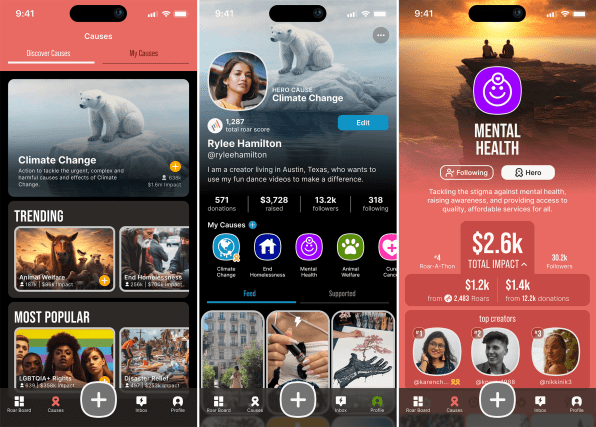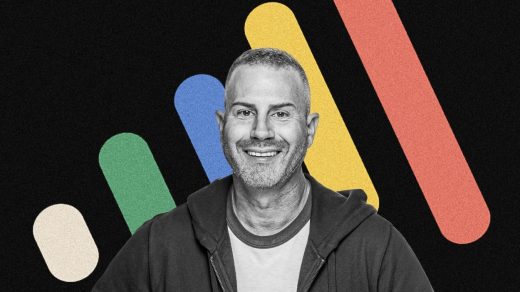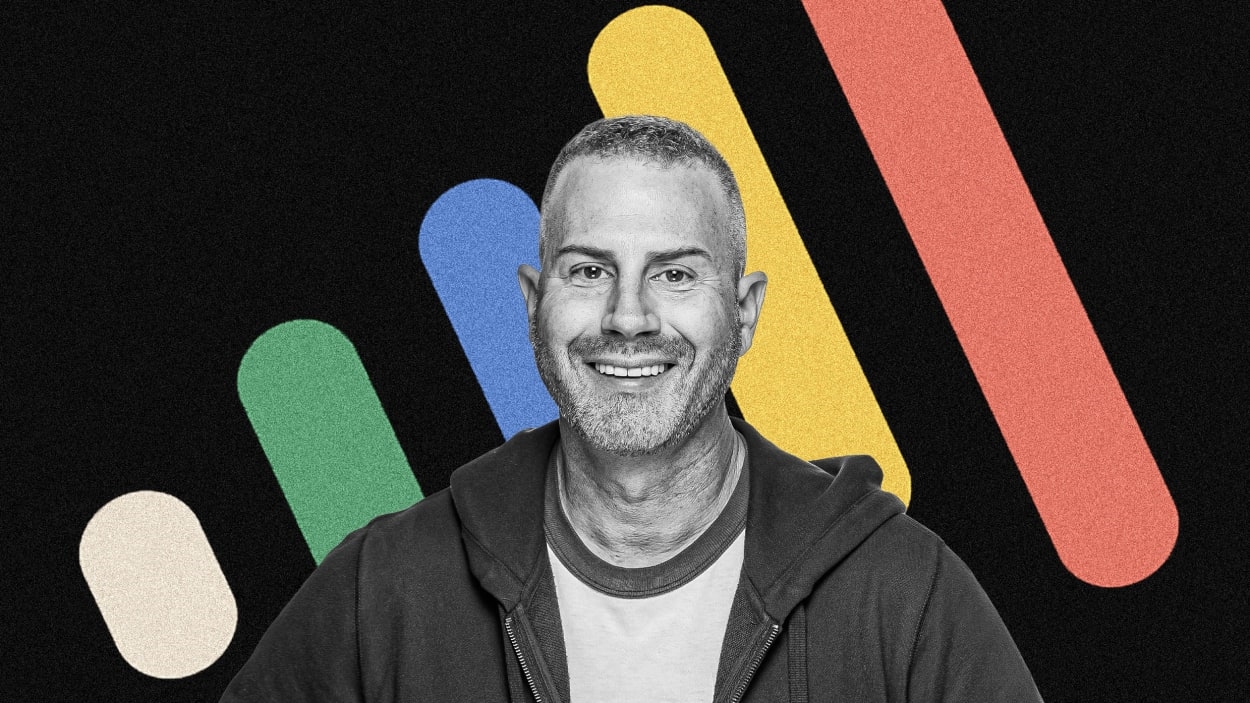Roar Social brings gamified charity to social media
A new social media platform aims to get younger generations involved in philanthropy by adding a viral component to giving.
Roar Social, the brainchild of media and tech veteran Robert Weiss, allows users—ideally Gen Z and younger millennials—to pick among more than a dozen “hero” causes, from climate change to homelessness. Their posts are then tagged under that cause, and others can give—rather than “like”—a micro-donation as small as a penny as a way of showing approval. Brands can also sign up for Roar Social and match those donations (Starbucks, Target, and Warby Parker have been listed as potential partners), all of which are eventually distributed via Roar Social’s 501(c)(3) foundation.
Roar Social launched in beta in the App Store today, armed with $11 million in seed funding and a board that includes former Bill & Melinda Gates Foundation CEO Jeff Raikes and MTV cofounder John A. Lack. Fast Company talked with Weiss, whose previous stints included the cable networks, FX and Fuse, and consumer-tech startups FanDragon and RockYou, about why he believes brands will want to get involved with Roar Social from the get-go. This interview has been edited for length and clarity.
Fast Company: How did you come up with the idea for Roar Social?
Robert Weiss: I had this idea literally when I was like 12 years old. My parents bought me my first Apple II computer, and I was obsessed. I took on computer programming, I coded, and I just had this idea that you could use technology as a tool to make the world a better place. And that sounds very altruistic, but that’s really who I was. Of course, I didn’t quite know how to use technology to make a difference, but that idea was in my head.
I got the idea for Roar Social—pretty close to what we’re launching, believe it or not—about 10 years ago. And I almost took it to market back in like 2012. But as much as I had a passion for this idea of using social media to have a positive impact, I didn’t think the marketplace could support the idea. But I had this hunch that Gen Z was going to move in that direction and really care about social impact. So fast-forward to the pandemic, and I found the idea in my iPhone notes section. I was like, Holy shit, this is the perfect time to launch this business.
FC: What was the fundraising experience like for you?
RW: First, I relied on the good graces of former colleagues and coworkers who just wanted to help out because they’re good people and they believed in my idea and invested some money. So in 2021, I finally had a nonworking prototype, and we pitched investors in our first SAFE note, and we got this amazing reaction. We raised about $5 million in about two months.
The feedback was that we had a really good idea, great team, and the right timing. So then, we ran with it. And then, when we had this $5 million, I didn’t start spending it right away; we assembled a small team to brainstorm further and to whiteboard the idea. I’ve seen too many smart people spend a lot of money having engineers build something, only then to take it to market in a pre-beta and then it’s like, “Oh my God, we got it wrong, let’s spend more money.” My strategy is to spend a little more time before hiring the engineers to try to get it right. So, we did a bunch of iterations, and then about four or five months later, we hired our engineering team and began building. We got really lucky because, thanks to the big idea, we were able to attract engineers from Google and Amazon and Apple and Microsoft. Most of them left jobs making twice as much money, but they really believed in the idea.
FC: And Roar Social is also hoping to bring in brands to match users’ donations. What’s the value proposition for brands? Why use Roar Social for donations?
RW: My hope was that because brands are spending around $20 billion a year in their CSR [corporate social responsibility] dollars, if we build an attractive platform where these brands can interact with Gen Z and young millennials in an authentic way, that was a home run. And I’m not asking brands to spend money that they’re not spending already, I’m asking them to redirect, essentially, those CSR dollars. For the vast majority of these Fortune 500 companies, the only way they tell the public that they are giving away billions of dollars is literally on their website, or through a press release—not exactly where Gen Z is hanging out.
And on Roar Social, we get to play essentially with the company’s money and help direct it toward charitable causes. So, if you’re going to give a five cent donation and a company is going to match it—and their logo appears constantly on the platform—that’s a great brand opportunity.
And one thing I should mention: We don’t take any money from the donations, period. Every penny goes to the nonprofits.

FC: How do you navigate potentially dealing with companies that want to give money but whose ethics you might not agree with? For example, what if Saudi Arabia’s wealth fund wants to match donations?
RW: That’s a great entrée for me to talk about brand building. Any good business needs to be true to its brand and its users. The most successful businesses, the ones that I admire—Apple, Nike, Starbucks, even Target—people kind of have a sense of their value system. And I think consumers are drawn to them because of what they stand for. Those are some North Star companies for me and for my team. So in building our brand, we’re going to have to say no as often as we say yes. If ultimately, because of the decisions we make to be true to our values, if we only build a $100 billion company and not a $400 billion company, I’m okay with that. I want to be very profitable; but the older I’ve gotten, the more it matters how I do it. That’s a value my team shares. Our investors all want to make a lot of money, and they’ve taken a bet on us—we’ve raised $11 million so far and counting—but they want us to do it the right way. Because that’s how you build a brand.
FC: I assume those values will apply to content moderation as well.
RW: It’s obviously been a problem on the legacy platforms, but because we’re looking to build a brand that Gen Z and young millennials can trust, our moderation policies are really strict. Now, if you look word for word at Meta’s or TikTok’s policies, they’re actually pretty strict. The problem is they don’t enforce [them], and they’re afraid to enforce [them].
If we’re targeting that young audience, we have to have the patience to build the right brand. Early on, I’m prepared to kick off users who are not following the rules. Now, you have to be consistent and fair, you have to be transparent about what those rules are.
But if you break the rules, it’s not like nine tries and you’re kicked off; we’re going to have a very short window where you get to redeem yourself. Let’s say the first month we kick off 100 people—I think we’re going to gain 1,000 users because I think people are going to be like, “Oh my God, there’s a platform that actually has a policy that is enforced.”
FC: There are 15 hero causes that Roar Social users can choose among, and that number is expected to grow to 25 in the coming months. How would you explain the concept of the hero cause?
RW: Each of those hero causes is essentially like an Impact Fund. Whether it’s animal welfare, or climate change, or homelessness—they’re all big buckets. Ultimately, the 25 that we’re going to end up with represent like 97% of all the causes.
When we first started working on this, I thought that when you sign up, you would pick a specific organization. And we realized in our early testing that even though Gen Z and millennials care a lot about causes, a lot of them did not know specific organizations. It became a paralyzing part of the signup process. So we changed our strategy, and we wanted to make it really turnkey. So we invented this notion of hero causes, and underneath the banner of, let’s say, animal welfare, there are going to eventually be hundreds of really good, 501(c)(3) charities. In the beta, you can just choose the hero cause; by the time we do a full go-to-market, you’re going to be able to choose a specific organization for a post.
FC: How did you select which nonprofits to feature on the app?
RW: The ones we’ve chosen are really based upon all the surveys we’ve done and research on Gen Z and millennials; we’ve chosen issues that resonate with them. We want to meet our audience where they are. Now, any organization can apply to be part of the platform. And we’re using existing vetting mechanisms, like Charity Navigator and Giving Compass, to help us decide whether they’re legit or not. And ultimately, they go on the platform if they meet that basic criteria. And also, we’re going to let our users decide who they want to have on the platform. If it turns out our users all rally behind a cause, it’ll end up on the platform—as long as it’s a legitimate 501(c)(3).
(16)



